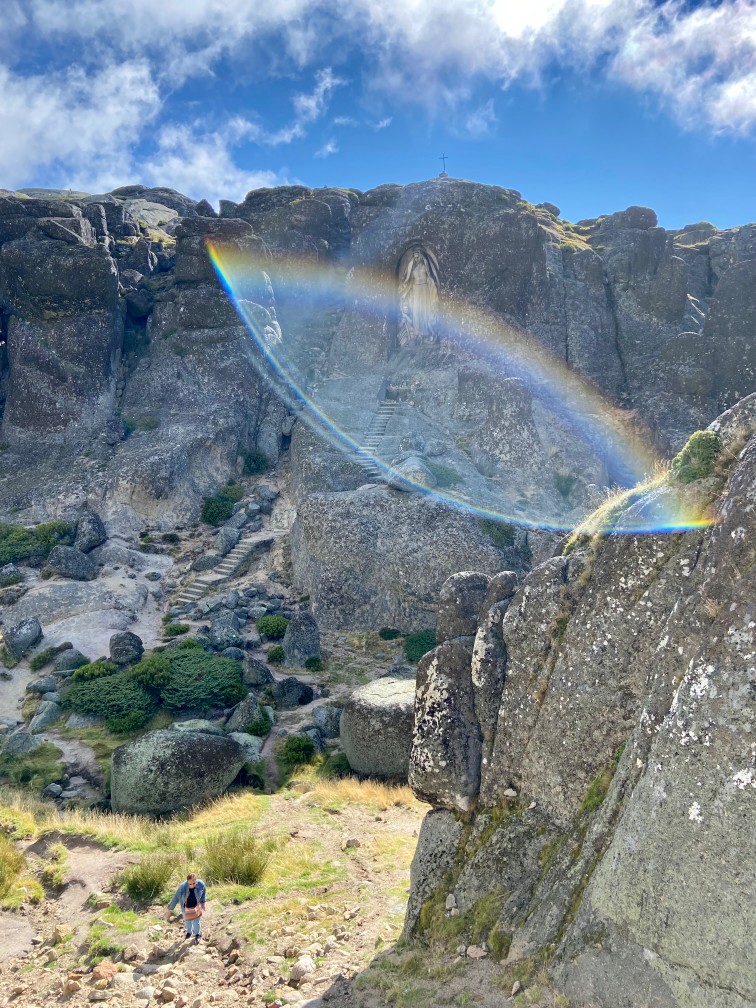The Final Stretch
Day 6-7
Most of the today will be spent snaking our way through Serra da Estrela to the village of Lousa. Stops along the way included the highest spot in continental Portugal.
The picture to the left shows a shrine to Our Lady of the Stars, patron saint of shepherds. The carving is impressive but there was very little information on the history of the site.


Just up the road from the rock carving is the highest point in continental Portugal. The Portuguese built a 7 meter tower so the elevation can be listed as 2000 meters. The peak is actually 1993 m.
The impact of the mountain range on weather was apparent the day we stopped there for an espresso break. You could watch a bank of clouds build on the western side of the slope.
The Village of Piódão.
All of the villages I’d seen on this trip had been fortified and served a strategic purpose. But the village of Piódão was isolated and difficult to reach, even by 21st century standards. The picture below is of a smaller village, Foz de Égua, lower on the mountainside.

The village of Piódão is camouflaged by its gray slate roofs. The location, high on the side of the mountain, provided good visibility and the added benefit of a treed landscape. From a distance, the small town would appear to be just part of the rocky terrain.
But why would anyone decide to live in such an isolated location in the late 1300’s.
Well, many years ago, the prince and heir to the Portuguese throne, Peter, had been promised to Constanza, a Spanish princess. A lady in waiting, Inês de Castro, caught the eye of the prince. He was captivated and hopelessly beguiled by the beautiful Inês.
He did his princely duty and fathered a son, Luis, with Constanza. Peter also maintained a separate household for Inês. They had three children and he would see her as often as possible. Peter also spent a great deal of time with Inês’s brothers. They were Castilian and urged Peter to claim the throne of Castile.
 Piódão didn’t have any white painted structures until the late 1800’s
Piódão didn’t have any white painted structures until the late 1800’s
These “foreigners” became his confidants and advisors. The Portuguese court was incensed.
Constanza dies shortly after the birth of her third child, Ferdinand. Now Peter believes he would be free to marry Inês and make her the future queen. His father was furious. The court was furious. Peter was still a royal and his next marriage must serve the needs of Portugal. The prince would never be allowed to marry Inês.
The King and Peter fought and argued. The nobles wanted Inês eliminated. She and her children were banished from court and moved to Monastery of Santa Clara-a-Velha.
On January 7, 1355, three Assassins, commanded by the king, went to the monastery. Inês was murdered in front of her children.
The prince was enraged. He waged war against his father ripping Portugal apart. The queen, Peter’s mother, eventually intervened and brokered a peace between father and son.
The King, stressed and weary from the wars, palace intrigue and the pressure of statesmanship, King Afonso dies. He was buried in the Lisbon Cathedral on May 28, 1357.
Peter ascends the throne. Since he was secretly married to Inês, their children are in line for the throne. Inês had never been recognized as the Queen of Portugal. Legend states that Peter has her body exhumed, sat her on the throne, dressed with a diadem and royal robes, and forced all his vassals to approach and kiss her decaying hand.
What is known to be true is that her body was exhumed and reburied at the Royal Monastery of Alcobaça. There, two beautiful carved tombs face each other with the inscription “ until the end of the world”.


But, back to our hidden village. The assassins were hunted down. Two of the three were put to a ghastly end. One assassin, Pacheco, escaped. Some say he fled to France, others say he hid in the mountains of Portugal.
The beautiful hamlet of Piódão, hidden in the mountains, has many inhabitants with Pacheco as a surname.
The love story has inspired poets and novelists. There are operas in English, French and German. Most recently, the movie The Dead Queen was released in 2018. So if you’re interested in a modern take on the story with much more court intrigue and revenge, you can catch the movie on Amazon Prime.
Our Last Hike
Back to the present – after a pleasant evening in Lousa, we’re off in the morning for the final hike to the villages of Talasnal and Casel Novo. It’s a steep climb along a narrow pathway and an even steeper descent. Carla, pictured below was one of our guides. She did a great job of keeping us
safe, pacing our hikes and stopping at appropriate intervals for morning espresso or an afternoon libation.


The red and yellow marks on the signs indicate we’re on a secondary path. A route connecting smaller or less significant villages. Red and white indicates a primary path.
The weather was beautiful and the trail, though a bit treacherous in areas, was well maintained.
A small cafe in Talasnal was a wonderful spot for our morning espresso. Yes, that is someone’s finger obscuring part of the picture.



The hike ended near the a grotto where I swam in crisp mountain water.

Now it’s back to Lisbon. I’ll explore Lisbon further and then head north to Porto.
Bom Dia